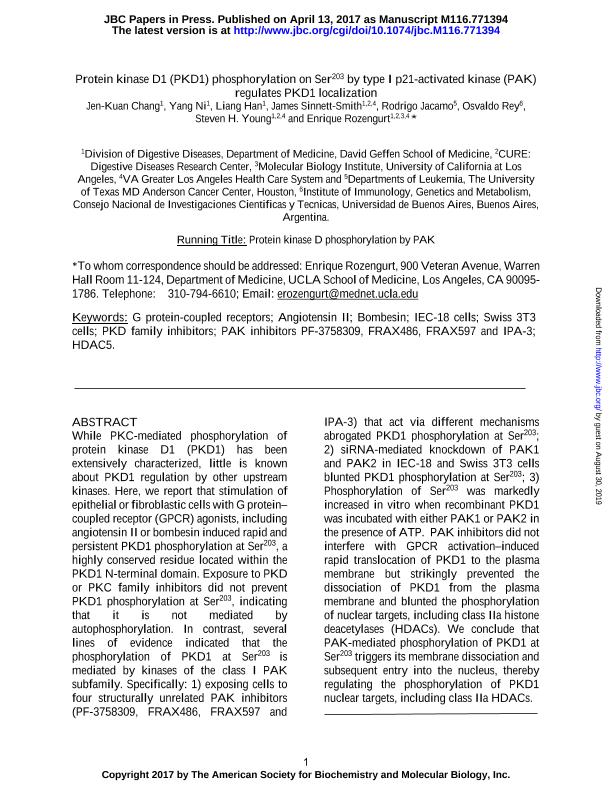Mostrar el registro sencillo del ítem
dc.contributor.author
Chang, Jen Kuan
dc.contributor.author
Ni, Yang
dc.contributor.author
Han, Liang
dc.contributor.author
Sinnett-Smith, James
dc.contributor.author
Jacamo, Rodrigo
dc.contributor.author
Rey, Osvaldo

dc.contributor.author
Young, Steven H.
dc.contributor.author
Rozengurt, Enrique
dc.date.available
2019-08-30T17:16:30Z
dc.date.issued
2017-06
dc.identifier.citation
Chang, Jen Kuan; Ni, Yang; Han, Liang; Sinnett-Smith, James; Jacamo, Rodrigo; et al.; Protein kinase D1 (PKD1) phosphorylation on Ser203 by type i p21-activated kinase (PAK) regulates PKD1 localization; American Society for Biochemistry and Molecular Biology; Journal of Biological Chemistry (online); 292; 23; 6-2017; 9523-9539
dc.identifier.issn
0021-9258
dc.identifier.uri
http://hdl.handle.net/11336/82596
dc.description.abstract
Although PKC-mediated phosphorylation of protein kinase D1 (PKD1) has been extensively characterized, little is known about PKD1 regulation by other upstream kinases. Here we report that stimulation of epithelial or fibroblastic cells with G protein-coupled receptor agonists, including angiotensin II or bombesin, induced rapid and persistent PKD1 phosphorylation at Ser203, a highly conserved residue located within the PKD1 N-terminal domain. Exposure to PKD or PKC family inhibitors did not prevent PKD1 phosphorylation at Ser203, indicating that it is not mediated by autophosphorylation. In contrast, several lines of evidence indicated that the phosphorylation of PKD1 at Ser203 is mediated by kinases of the class I PAK subfamily, specifically 1) exposing cells to four structurally unrelated PAK inhibitors (PF-3758309, FRAX486, FRAX597, and IPA-3) that act via different mechanisms abrogated PKD1 phosphorylation at Ser203, 2) siRNA-mediated knockdown of PAK1 and PAK2 in IEC-18 and Swiss 3T3 cells blunted PKD1 phosphorylation at Ser203, 3) phosphorylation of Ser203 markedly increased in vitro when recombinant PKD1 was incubated with either PAK1 or PAK2 in the presence of ATP. PAK inhibitors did not interfere with G protein-coupled receptor activation-induced rapid translocation of PKD1 to the plasma membrane but strikingly prevented the dissociation of PKD1 from the plasma membrane and blunted the phosphorylation of nuclear targets, including class IIa histone deacetylases. We conclude that PAK-mediated phosphorylation of PKD1 at Ser203 triggers its membrane dissociation and subsequent entry into the nucleus, thereby regulating the phosphorylation of PKD1 nuclear targets, including class IIa histone deacetylases.
dc.format
application/pdf
dc.language.iso
eng
dc.publisher
American Society for Biochemistry and Molecular Biology

dc.rights
info:eu-repo/semantics/openAccess
dc.rights.uri
https://creativecommons.org/licenses/by-nc-sa/2.5/ar/
dc.subject
Gpcr
dc.subject
Pkd
dc.subject
Pak
dc.subject
Cancer
dc.subject.classification
Bioquímica y Biología Molecular

dc.subject.classification
Ciencias Biológicas

dc.subject.classification
CIENCIAS NATURALES Y EXACTAS

dc.title
Protein kinase D1 (PKD1) phosphorylation on Ser203 by type i p21-activated kinase (PAK) regulates PKD1 localization
dc.type
info:eu-repo/semantics/article
dc.type
info:ar-repo/semantics/artículo
dc.type
info:eu-repo/semantics/publishedVersion
dc.date.updated
2019-08-30T14:17:31Z
dc.journal.volume
292
dc.journal.number
23
dc.journal.pagination
9523-9539
dc.journal.pais
Estados Unidos

dc.journal.ciudad
Bethesda
dc.description.fil
Fil: Chang, Jen Kuan. University of California at Los Angeles. School of Medicine; Estados Unidos
dc.description.fil
Fil: Ni, Yang. University of California at Los Angeles. School of Medicine; Estados Unidos. Shandong University; China
dc.description.fil
Fil: Han, Liang. University of California at Los Angeles. School of Medicine; Estados Unidos. Xi'an Jiaotong University; China
dc.description.fil
Fil: Sinnett-Smith, James. University of California at Los Angeles. School of Medicine; Estados Unidos
dc.description.fil
Fil: Jacamo, Rodrigo. University Of Texas Md Anderson Cancer Center;
dc.description.fil
Fil: Rey, Osvaldo. Consejo Nacional de Investigaciones Científicas y Técnicas. Oficina de Coordinación Administrativa Houssay. Instituto de Inmunología, Genética y Metabolismo. Universidad de Buenos Aires. Facultad de Medicina. Instituto de Inmunología, Genética y Metabolismo; Argentina
dc.description.fil
Fil: Young, Steven H.. University of California at Los Angeles. School of Medicine; Estados Unidos. University of Texas; Estados Unidos
dc.description.fil
Fil: Rozengurt, Enrique. University of Texas; Estados Unidos. University of California at Los Angeles. School of Medicine; Estados Unidos
dc.journal.title
Journal of Biological Chemistry (online)

dc.relation.alternativeid
info:eu-repo/semantics/altIdentifier/url/http://www.jbc.org/cgi/pmidlookup?view=long&pmid=28408623
dc.relation.alternativeid
info:eu-repo/semantics/altIdentifier/doi/http://dx.doi.org/10.1074/jbc.M116.771394
dc.relation.alternativeid
info:eu-repo/semantics/altIdentifier/url/https://www.ncbi.nlm.nih.gov/pmc/articles/PMC5465480/
Archivos asociados
